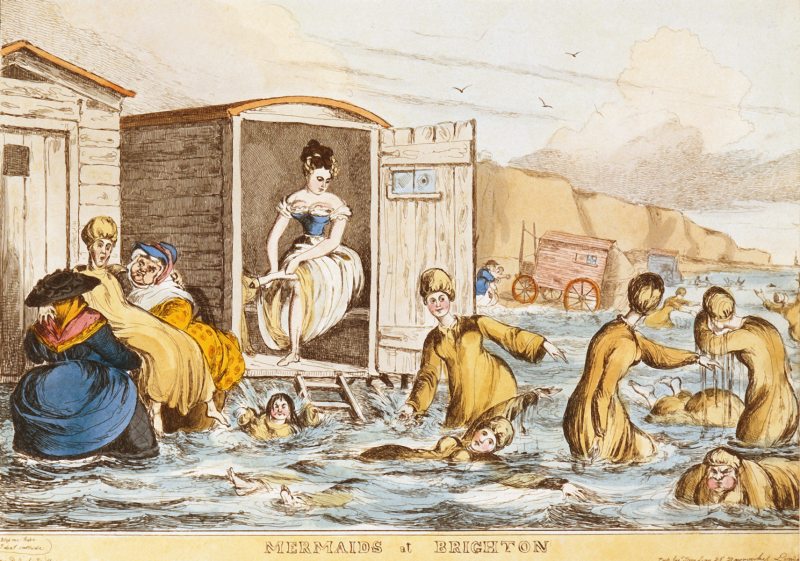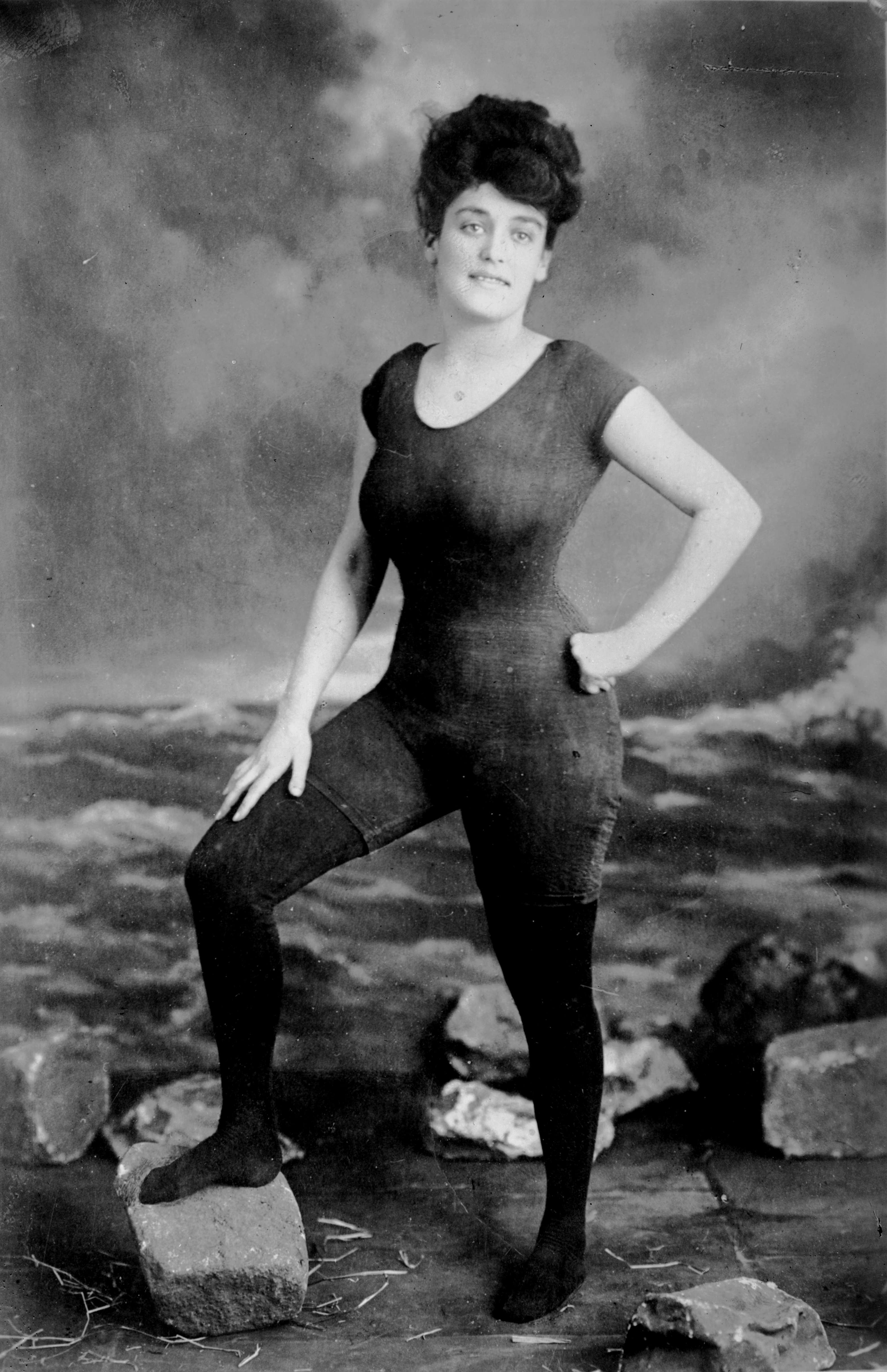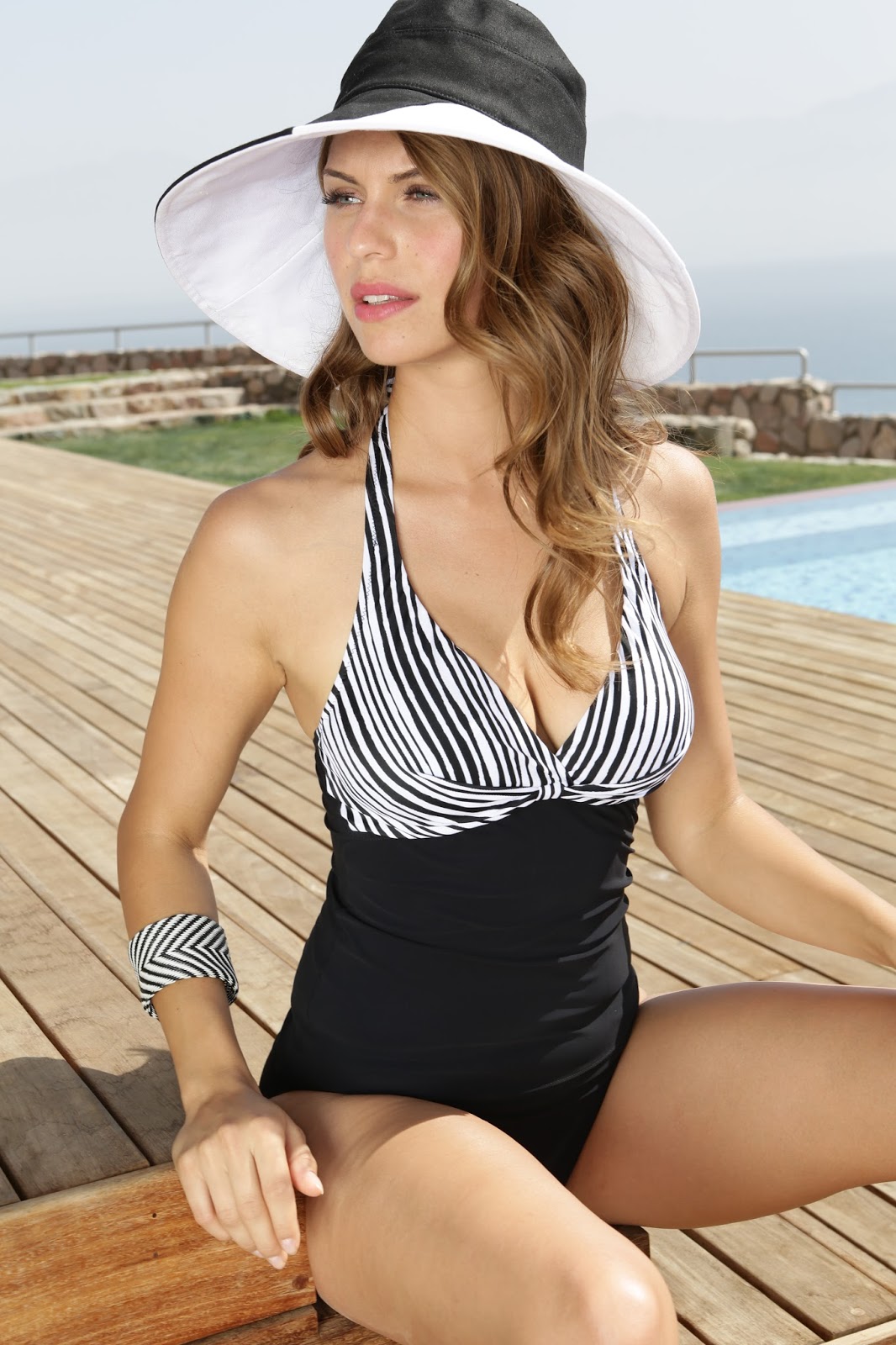Aah, the swimsuit. The
brightly-colored, body-hugging, high-tech miracle we know today is vastly
different from its ancestors; in fact, it bears absolutely no resemblance. Influenced by technology, fashion, and standards
of morality, swimsuits have evolved drastically over the last 200 years. Let’s take a little walk through swimwear’s
history.
Swimwear in Victorian Times
 |
| Women's Bathing Dress, circa 1858 By Harpers magazine via Wikimedia Commons PD |
The Victorian lady would don a long swimming dress, with full-coverage
sleeves and a discreet neckline, along with bloomer-style pants
underneath. To keep the skirt from
floating upwards, the hemline sometimes included weights. The garments were made of wool, and were often
black or darkly colored. Topping off the
look were dark stockings, bathing shoes, and perhaps a hat. Let’s pause to consider how the early
Victorian woman must have felt during a trip to the beach. She’s wearing more clothing than most of us
ever wear (even in cold weather), it’s long, billowy, weighted, and made of
wool. After frolicking (if even possible) on the beach,
she goes for a quick dip in the sea, where her voluminous layers of wool get
drenched. It sounds dreadfully
uncomfortable, and extremely impractical, but at least nobody got a peak at her
knee. As the 19th century
progressed, so did women’s swimwear, albeit slowly. Sleeve lengths got shorter, as did hemlines (ankles
were spotted!).
 |
| A bathing machine is depicted in "Mermaids at Brighton" by William Heath via Wikimedia Commons, PD-Art |
Turn of the Century Swimwear Innovations
 |
| Annette Kellerman in her bathing suit via Wikimedia Commons Photographer unknown, PD |
In the first decade of the 1900’s, a professional swimmer named Annette Kellerman created a stir by designing and wearing a one piece bathing suit. Similar to a unitard, this new style was form-fitting, hitting the legs mid-thigh, and with very short sleeves. Though she wore it with stockings, it was still considered indecent and she was arrested. Kellerman successfully defended her bathing suit’s design as necessary to enjoying swimming as exercise, and went on to create a line of swimwear.
 |
| Michele Morgan c. 1940 via Wikimedia Commons, Photographer unknown, PD |
The Bikini Explosion: the 40's and 50's
| Marilyn Monroe in a bikini via Wikimedia Commons Tichnor Bros,Inc, PD |
In 1947, the Bikini’s introduction produced the intended reaction of a bomb being dropped. Consisting of very little fabric, the new skimpy two-piece bathing suits scandalized the world as beaches attempted to ban their use. After a few years, however, the bikini started to make appearances, as bold starlets wore them in public places. In 1960, “Itsy Bitsy Teenie Weenie Yellow Polka Dot Bikini”, sung by Bryan Hyland, soared to the top of the charts in the United States, along with the bikini’s popularity.
 |
| Vintage 1970's Gottex Monokini Photo courtesy of SwimSkins on Etsy |
 |
| Tankini and "Infinity" sun hat by Profile by Gottex |
Swimwear Trends Today
Since the 1960’s, swimwear has changed along with fashion, featuring colors, patterns and cuts that reflected the broader trends. Always popular, the one-piece bathing suit has held its place as swimwear’s go-to style. Not to be outshone, the two-piece has maintained its place in swimwear with developments such as the thong in the 1980’s, and (on the opposite end of the coverage spectrum) the tankini in the 1990’s. In recent decades, “shapewear” and swimwear have merged, using high-tech fabrics and clever designs to hide bumps and smooth lumps.
 |
| Women's Swim Shirt by Victory |
seeing widespread use by children and adults alike. Swim shirts were the next development; the rash guard’s looser cousin.
From the abundant tiers of fabric that the Victorians swam in, to the mere inches of fabric in a teeny weeny bikini, we’ve reached a time when it seems there’s something to “suit” everyone. Trendy bikinis abound for the body-con fashionista, and one-piece bathing suits in figure-flattering styles and beautiful fabrics are bountiful. For the sun conscious, swim shirts and rash guards provide excellent coverage, and those seeking to supplement their look with sun hats, cover-ups and accessories have plentiful options.
With such dramatic changes in the last two centuries, it’s fun to ponder: what will the future of swimwear will hold?
Sources: Vintage Fashion Guild, Victoriana Magazine, Australia.gov, Fashion Maniac, Los Angeles Times


Love this! I had no idea. Thank *God* I live in the 21st century where I have a ton of choice about what to wear. :) So well written. Thanks for sharing!
ReplyDelete